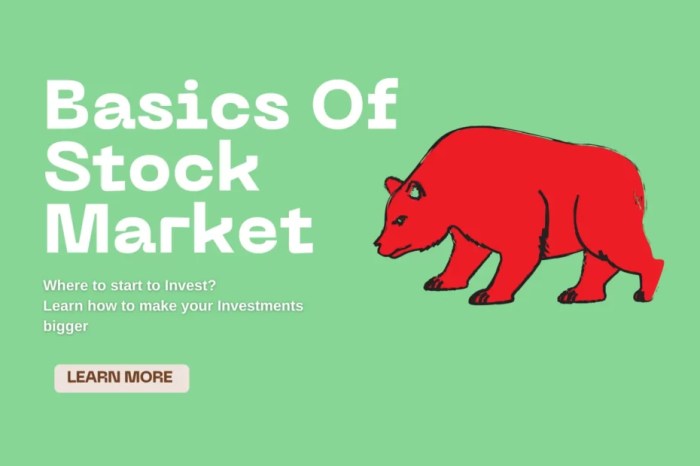Stock Market Basics takes center stage, inviting readers into a world of financial knowledge that’s both informative and exciting. From defining the stock market to exploring different types of stocks and market participants, this overview sets the stage for a deep dive into the dynamics of trading.
Stock Market Basics

When it comes to the stock market, it serves as a platform where individuals and institutions can buy and sell shares of publicly traded companies. This allows companies to raise capital by selling ownership stakes, while investors can potentially earn returns as the value of the shares fluctuate.
Buying and Selling Shares
Buying shares means acquiring ownership in a company, giving investors a stake in its profits and losses. On the other hand, selling shares involves transferring ownership to another party, either for a profit or a loss depending on the share price movement.
Role of Stock Exchanges
Stock exchanges act as marketplaces where buyers and sellers come together to trade shares. They provide a transparent and regulated environment for trading, ensuring fair prices and efficient transactions.
Importance of Stock Market Indices
Stock market indices, such as the S&P 500 or Dow Jones Industrial Average, track the performance of a group of stocks representing a particular market or sector. These indices serve as benchmarks to measure the overall market performance and help investors gauge the health of the economy.
Types of Stocks
When it comes to stocks, there are various types that investors can choose from based on their risk tolerance, investment goals, and overall strategy. Let’s dive into the different types of stocks to help you navigate the stock market with confidence.
Common Stocks vs Preferred Stocks
Common stocks are the most basic type of stock that represents ownership in a company and comes with voting rights at shareholder meetings. On the other hand, preferred stocks are a type of stock that gives shareholders priority over common stockholders in terms of dividends and assets in the event of liquidation.
Blue-Chip Stocks
Blue-chip stocks refer to shares of large, well-established companies with a history of stable earnings and reliable performance. These stocks are known for their stability and are considered safe investments for long-term growth.
Growth Stocks vs Value Stocks
Growth stocks are shares of companies that are expected to grow at a faster rate than the overall market. These stocks typically reinvest earnings into expanding the business rather than paying dividends to shareholders. On the other hand, value stocks are stocks that are considered undervalued by the market and have the potential for price appreciation.
Risks of Penny Stocks
Penny stocks are shares of small companies that trade at a low price, often below $5 per share. While they may seem attractive due to the potential for high returns, penny stocks are highly speculative and come with significant risks, including volatility, lack of liquidity, and potential for fraud.
Stock Market Participants: Stock Market Basics
Investors, traders, brokers, investment bankers, institutional investors, and retail investors all play crucial roles in the stock market ecosystem. Each participant brings a unique perspective and impact on market dynamics.
Investors
Investors are individuals or entities who purchase securities like stocks with the expectation of generating a return on their investment. They can be classified into different categories based on their investment goals, risk tolerance, and holding periods.
- Individual Investors: These are retail investors who buy and sell stocks for personal investment purposes. They may include beginners, seasoned investors, and day traders.
- Institutional Investors: These are large organizations such as mutual funds, pension funds, and hedge funds that invest on behalf of their clients or shareholders. They have significant influence on stock prices due to the size of their holdings.
Traders
Traders are market participants who engage in frequent buying and selling of stocks or other securities to profit from short-term price movements. They may utilize different trading strategies such as day trading, swing trading, or high-frequency trading.
- Day Traders: These traders buy and sell stocks within the same trading day, aiming to capitalize on intraday price fluctuations.
- Swing Traders: Swing traders hold stocks for a few days to weeks, aiming to profit from short to medium-term price trends.
Brokers
Brokers act as intermediaries between buyers and sellers in the stock market. They execute trades on behalf of their clients and provide various services such as investment advice, research reports, and trading platforms.
Brokers play a vital role in facilitating smooth and efficient trading activities in the stock market.
Investment Bankers
Investment bankers assist companies in raising capital by underwriting new stock offerings or facilitating mergers and acquisitions. They provide financial advisory services and help companies navigate complex financial transactions.
- Underwriting: Investment bankers guarantee the sale of newly issued stocks to investors, helping companies raise funds for expansion or other corporate purposes.
- Mergers and Acquisitions (M&A): Investment bankers advise companies on strategic transactions such as mergers, acquisitions, or divestitures to enhance shareholder value.
Stock Market Order Types

When trading stocks, investors use different types of orders to buy or sell shares. Understanding the various order types is crucial for effectively managing investments and minimizing risks.
Market Orders and Limit Orders
- Market Orders: Market orders are instructions to buy or sell a stock at the current market price. These orders are executed immediately at the best available price.
- Limit Orders: Limit orders allow investors to set a specific price at which they are willing to buy or sell a stock. The trade will only be executed if the stock reaches the specified price.
Stop-Loss Orders and Risk Management, Stock Market Basics
- Stop-Loss Orders: A stop-loss order is a type of order placed to limit potential losses by automatically selling a stock once it reaches a predetermined price. This helps investors manage risk and protect their investment capital.
Significance of Stop-Limit Orders
- Stop-Limit Orders: Stop-limit orders combine the features of stop orders and limit orders. When the stock reaches a specified price (the stop price), the order becomes a limit order, which will only be executed at the limit price or better. This allows investors to have more control over the price at which their order is executed.
Purpose of Trailing Stop Orders
- Trailing Stop Orders: Trailing stop orders are designed to protect profits by allowing investors to set a trailing stop percentage below the stock’s market price. If the stock price falls by the specified percentage, the order is triggered, helping investors lock in gains and minimize potential losses.








